PHOTO: Sunfield housing development, Auckland. STUFF
According to STUFF when the Urban Development Bill was going through its third reading in Parliament, Green MP Julie Anne Genter likened the kind of developments that would be green-lit to the solar panel-filled, almost car-free German city of Freiburg.
It’s a place so peaceful that, it is said, the only sounds you can hear are birdsong and the laughter of children.
“Imagine living in this kind of community. It means that you can walk right down to the shops, that houses were built to the highest energy-efficiency standard – incredibly warm, many with solar panels, and all of them surrounded by lush green gardens. This type of living isn’t a dream. It exists.”
The then-Minister for Urban Development Phil Twyford said the bill would enable a new type of urban development that would be good for the environment, transform communities, improve housing options, provide access to jobs, green spaces, and amenities.
Most importantly, for these big complex and sustainable developments, the bill was supposed to fix a perennial problem seen in every corner of New Zealand’s planning and consenting system: speed – or rather, the lack of it.
“This legislation is about having a public agency – Kāinga Ora – that can partner with the private sector, with iwi, and with local government to de-risk these projects so that people will invest in them and make them happen,” Twyford said.
“This bill addresses the barriers to complex development by creating a streamlined process that gets decisions made upfront in an integrated way, and it will enable large-scale developments to happen much more quickly.
“It represents a new way of doing urban development. Specified Development Projects (SDPs) that are set out in this bill are the kind of complex projects that, by and large, New Zealand has not undertaken.

“These projects have a scale that means they have the potential to transform our urban areas and deliver desperately needed housing and infrastructure.”
At first glance NZX-listed property developer Winton’s $4b Sunfield development would seem to an easy fit with the bold visions politicians had when Parliament passed the Urban Development Act (UDA) under urgency.
Winton’s Papakura-based Sunfield development contains 4400 homes and three retirement villages, it has 22.8 hectares of green space and is powered by a renewable solar energy network courtesy of solar panels on the rooftops of almost every building in the development with large batteries feeding excess energy back into the grid during non-daylight hours.
The project is master-planned and car-free with transport provided by an autonomous electric shuttle fleet.
Kāinga Ora runs the process behind who gets to use the UDA’s powers, but when Twyford shepherded the Act through Parliament he made it clear private and public parties would both be able to access the legislation.
“It’s not our intent that by inserting central government into this space, we displace the private sector or the other key actors – iwi and local government,” Twyford said.
“It is our view that this legislation should be an enabler, and it’s my hope that developers will come forward, that councils will come forward, and that iwi and others will come forward with proposals to use this legislation to lead large-scale urban development projects.”
MOST POPULAR
- Former real estate agent jailed for secretly filming his encounters with sex workers
- Illegal boarding house shut down
- Claims about Jacinda Ardern’s wealth
- Toy billionaire Anna Mowbray and Ali Williams’ secret weapon in new home build
- Abandoned land for sale
- Grand Designs | Brighton: Beach House – WATCH
- House prices tipped to fall further in 2023 | The biggest correction in NZ’s history
- THE ANCIENT STONE CITY: Proof of NZ civilisation before Kupe
- 10 Best Nudist Beaches in New Zealand
- Empire State Building real estate billionaire enrages New Zealand neighbors



















